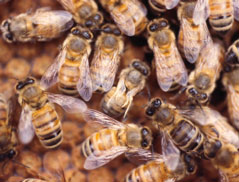
Origins and Distribution of V. destructor
V. destructor is an obligate parasite of cavity-dwelling Apis bees. It cannot reproduce on yellow jackets, wasps, bumblebees or any other species. Early reports of this mite on the western honey bee inaccurately identified it as V. jacobsoni Oudemans, which exists in a sustainable association with the eastern honey bee, A. cerana. In 2000, the genus Varroa was reported to consist of at least two species, V. jacobsoni (which infects A. cerana, but not A. mellifera) and V. destructor (which infects both A. cerana and A. mellifera). Consequently, literature reporting on V. jacobsoni and the western honey bee prior to that time actually refers to V. destructor.
The association of V. destructor with the western honey bee reportedly originated in the 1950s, when mites transferred to A. mellifera colonies introduced to the home range of A. cerana. Subsequently, V. destructor has established a nearly cosmopolitan distribution with respect to its new host, with Australia being the only mite-free continent. V. destructor was discovered in the U.S. in 1987. Due to the highly mobile nature of both the honey bee and the U.S. beekeeping industry, V. destructor quickly became endemic, and it can now be found in every state in the continental U.S.
